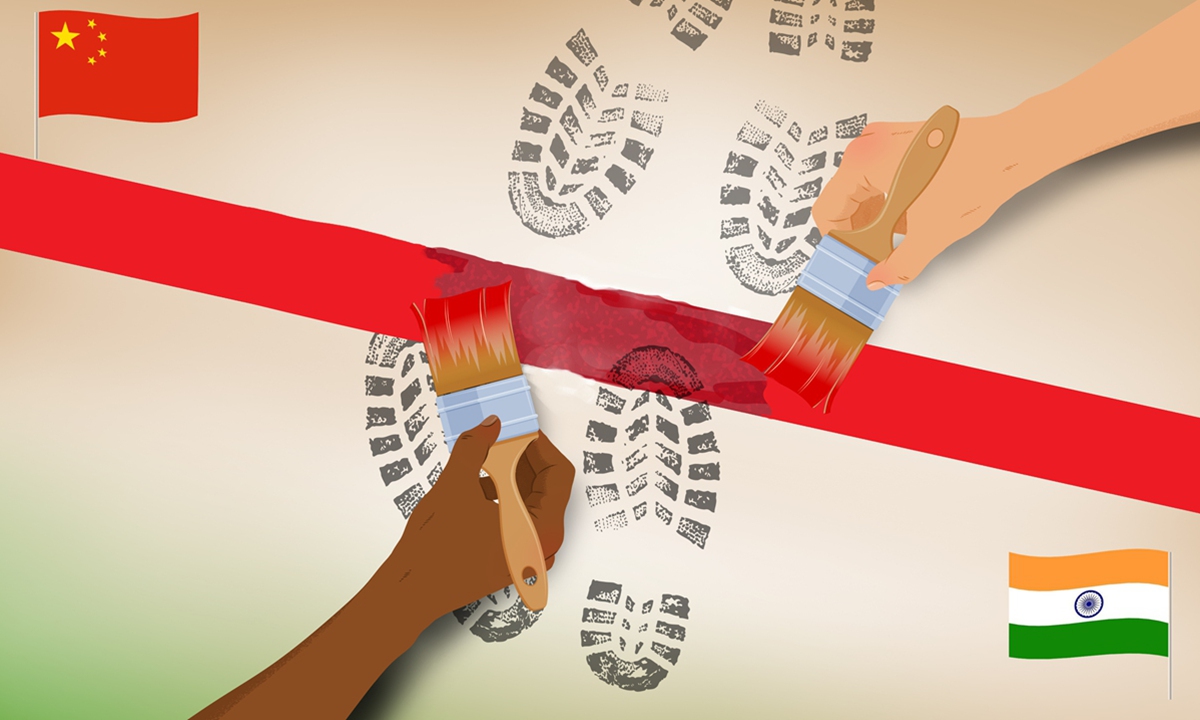Can ‘Wuhan Spirit' be revived between China, India?

China India Photo: GT
Tuesday marks the first anniversary of the Galwan Valley conflict between India and China. Right now, China-India relations are still facing difficulties. Most Indian scholars attribute the serious deterioration of China-India relations to the Galwan conflict. But from my humble observation, the Galwan situation is an inevitable result, not a cause, of the development of bilateral ties. Nevertheless, it is undeniable that the Galwan conflict provides an excuse for India to implement de-sinicization measures in economy.COVID-19 has had a great impact on the cognition and psychology of India's strategic circle and policymakers. This has led to the adjustment of New Delhi's foreign policy, especially because of India's perception of the so-called strategic opportunity at the beginning of the pandemic in China and the psychological changes caused by the subsequent collapse of the "opportunity." But the pandemic was just a catalyst for the dramatic acceleration of India's domestic economic policy and foreign strategy adjustment. In fact, this adjustment began around five years ago, and has accelerated since Indian Prime Minister Narendra Modi's reelection in 2019. COVID-19 has further accelerated this adjustment, mainly due to the serious misjudgments of India's strategic circles and policymakers.
Firstly, in April-May 2020, Indian policy elites believed that India would face a "totally different world order" after the pandemic. They believe the international status of both China and the US would be seriously weakened in this scenario. The global pandemic would help strengthen India-US relations and facilitate India's rise. India could then play an important role in the post-pandemic international order.
Secondly, Indian policy elites believe that the pandemic was a golden opportunity to develop "Make in India" and free themselves from economic dependence on China. It could then take over China's position with global industrial and supply chains. The pandemic would also provide a once-in-a-generation opportunity for India to implement a nationwide industrial policy.
Finally, some Indian policy elites believe that COVID-19 has beset China with difficulties internally and externally — and presented a good time for India to accelerate its Act East Policy and Indo-Pacific strategy. It would weaken China's global and regional influence by putting pressure on China along its border to accept India's demands.
They predicted in April 2020 about the possibility of an incident like the 1962 border conflict between China and India. Then in May last year, there were standoffs in the boundary areas, and on June 15 the Galwan skirmish broke out. After the Galwan clash, India adopted many policies that are harmful to China but not beneficial to itself. This has damaged the foundation of bilateral relations that have existed peacefully for more than 30 years.
One year since the Galwan conflict, we have seen few people in India seriously reflect on why China-India relations have deteriorated to such a point today. New Delhi has been asking Beijing to take concrete measures to rebuild India's trust in China. In his speech a few weeks ago, External Affairs Minister S. Jaishankar still put the blame entirely on China.
In 2012 and 2013, I published articles on the "competitive symbiotic relationship" between China and India. What is meant by "competitive symbiosis?" First of all, we must admit that there are some competitive aspects in China-Indian relations, including in geopolitics, commodity markets and energy, etc. But these competitions are not necessarily zero-sum games. The key is how to understand and deal with these problems.
Apart from the competitive aspect, the "symbiosis" of China-India relations is mainly reflected in four aspects. Firstly, as two powers rise almost simultaneously, China and India share common interests in the reform of the international system and need to strengthen cooperation. We can see at the Meeting of the BRICS Ministers of Foreign Affairs/International Relations on June 1, the five foreign ministers sent a clear signal in their joint communique to "support the strengthening and reform of the multilateral system" and put forward a number of initiatives.
Secondly, in the trilateral relationship among China, the US and India, India's rise has benefited from China's fast ascent. Without China's rise, the US would not have attached importance to India. Yet if India sacrifices its relations with China to curry favor of the US, New Delhi cannot get real help from Washington.
Regardless, India needs to keep a proper balance in dealing with its relations with China and the US.
Thirdly, development is the top priority for both China and India. Development cannot be achieved without a stable neighborhood. So, it is in the common interests of both countries to maintain regional stability and tranquility along the border.
Lastly, the two countries are complementary economically. In 2020, the Indian government promoted decoupling from China forcefully, but China regained its position as India's largest trading partner. Moreover, economic development requires right partners, and the US and Western countries want to bring back capital and manufacturing to their own countries. They want to build more resilient supply and industrial chains, but India does not meet their conditions.
Although nearly a decade has passed, the essence of China-Indian relations remains "competitive symbiosis," and China's policy toward India remains unchanged. However, the Indian side has changed its thinking and mentality towards China. New Delhi has exaggerated the geopolitical competition between the two countries and regards it as a zero-sum game. New Delhi regards China-US strategic competition as a good opportunity to contain Beijing and it even hopes to set up an industrial chain and supply chain to replace China at the expense of China's interests. This has proved to be a pipe dream.
In the two informal summits between the top leaders in Wuhan and Chennai, China has been very accommodating to India's concerns, proposing "China-India Plus" to take account of India's geopolitical interests in South Asia, establishing a high-level economic and trade forum and a "manufacturing partnership" to address India's trade concerns. China has also continued to promote border negotiations between the two countries. But the key issue is that respect should be mutual, which is the only solution.
The author is secretary-general of the Research Center for China-South Asia Cooperation at Shanghai Institutes for International Studies, a visiting fellow of the Chongyang Institute for Financial Studies, Renmin University of China, and a distinguished fellow of the China (Kunming) South Asia & Southeast Asia Institute. opinion@globaltimes.com.cn



